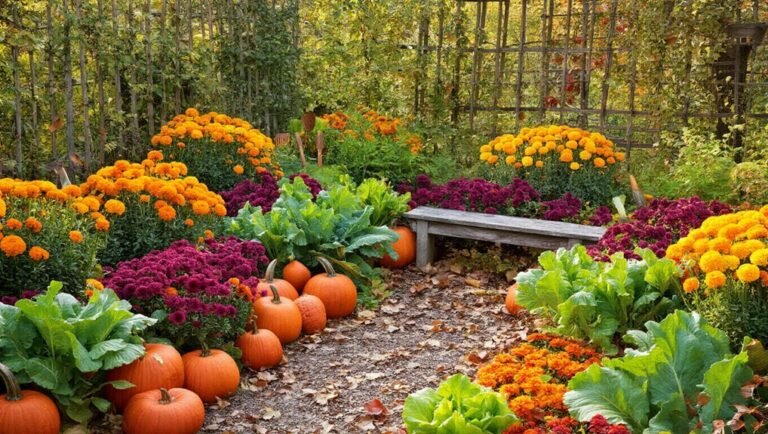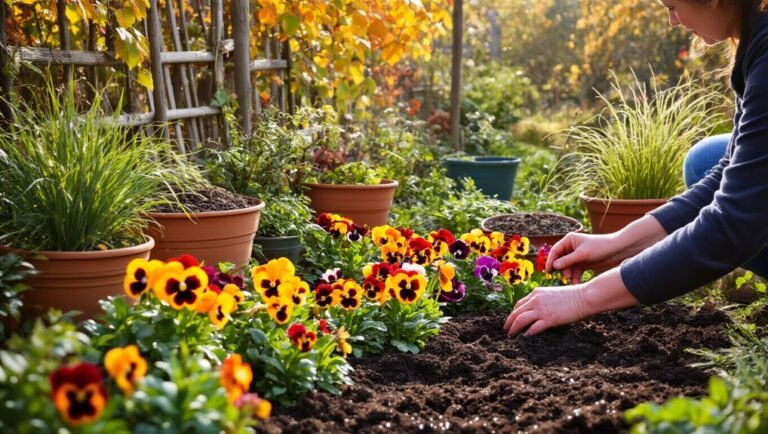For a “plant & forget” garden, low-maintenance perennials like sedum, black-eyed Susan, daylily, and coneflower are perfect. They thrive with minimal care and bring vibrant blooms year after year. Hardy groundcovers, such as creeping thyme and ajuga, can also enhance your garden while requiring little attention. These drought-resistant plants offer resilience against pests and adapt well to various conditions. Explore more options and tips to create a beautiful, carefree outdoor space.
Key Takeaways
- Choose drought-resistant perennials like sedum and coneflower for minimal watering and maintenance.
- Select hardy groundcovers, such as creeping thyme and ajuga, to suppress weeds and retain soil moisture.
- Group plants by sunlight and water needs to simplify care and enhance visual appeal.
- Incorporate mulch to control weeds, retain moisture, and improve soil quality while beautifying the garden.
- Opt for a variety of perennials that bloom in different seasons for year-round interest with minimal effort.
Why Choose Low-Maintenance Perennials?
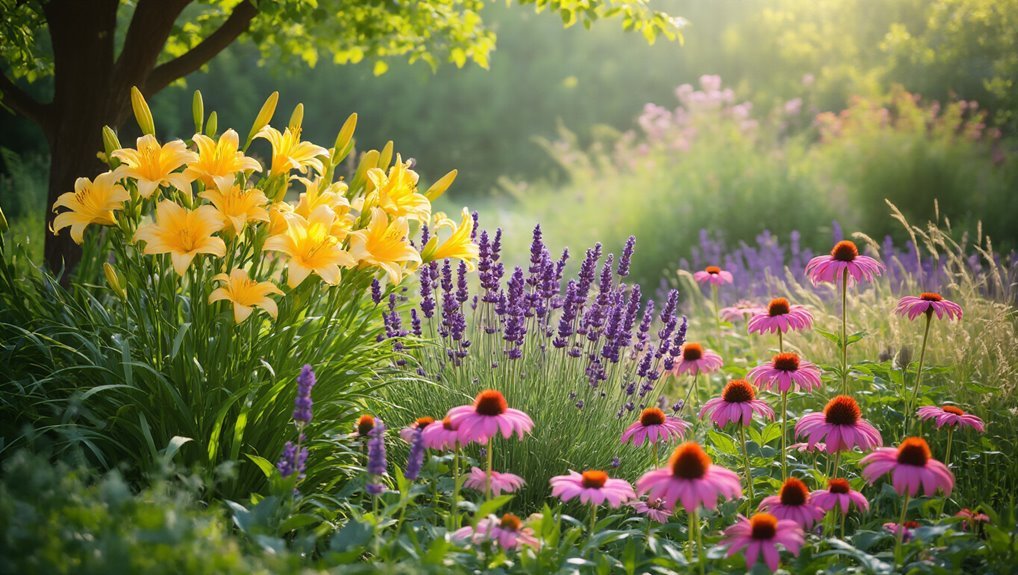
Choosing low-maintenance perennials can save you time and effort, especially if you want a beautiful garden without constant upkeep. By selecting these hardy plants, you’ll enjoy vibrant blooms year after year with minimal care.
Low-maintenance perennials are typically drought-resistant, resilient to pests, and thrive in various soil conditions. This means you won’t need to worry about frequent watering or applying pesticides, allowing you to spend more time enjoying your garden rather than working in it. To keep your garden even healthier, you can utilize Garden Pest Traps to manage insects without resorting to chemical sprays.
Additionally, they can effectively fill your garden space and create a stunning landscape with less planning and effort. Ultimately, low-maintenance perennials are the perfect choice for busy gardeners or those who simply prefer a more relaxed approach to gardening.
To further protect your low-maintenance plants, consider using garden netting to safeguard them from pests and harsh weather conditions.
Top Perennial Flowers for Minimal Care
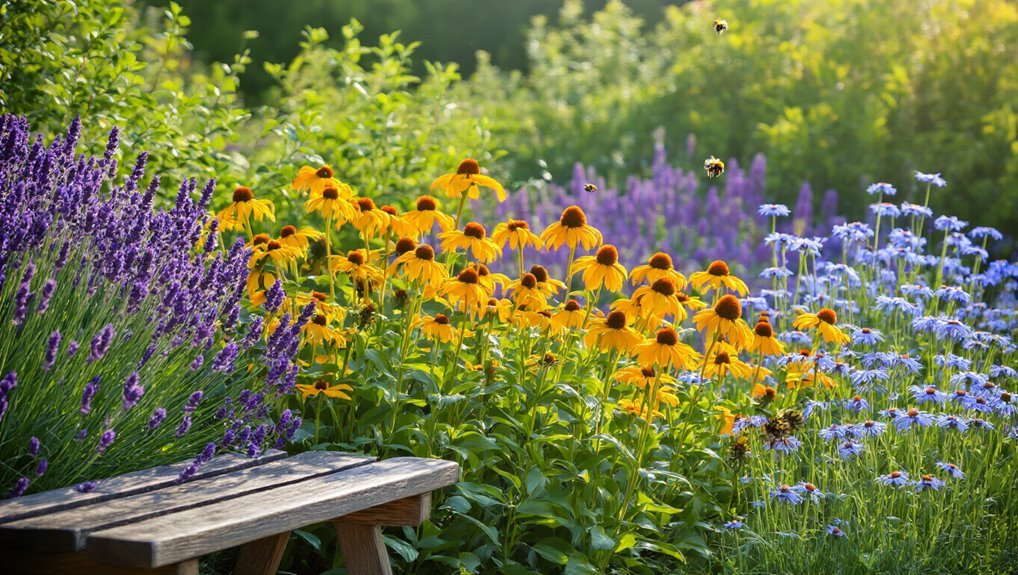
When it comes to low-maintenance gardening, selecting the right perennial flowers can make all the difference. Consider these top choices that thrive with minimal care, allowing you to enjoy a beautiful garden without constant attention.
| Flower | Light Requirements |
|---|---|
| Sedum | Full sun |
| Black-eyed Susan | Full sun to part shade |
| Daylily | Full sun to part shade |
These perennials not only offer stunning blooms but also adapt well to various soil conditions. Once established, they’re resistant to pests and diseases, making them perfect for a “plant and forget” garden. For even healthier, low-maintenance beds, consider using mulch in your garden, as it helps retain moisture and suppress weeds. Using organic mulching materials like straw can also improve soil health and reduce the need for frequent watering. So, go ahead and choose these flowers for a vibrant, hassle-free landscape.
Hardy Groundcovers to Consider
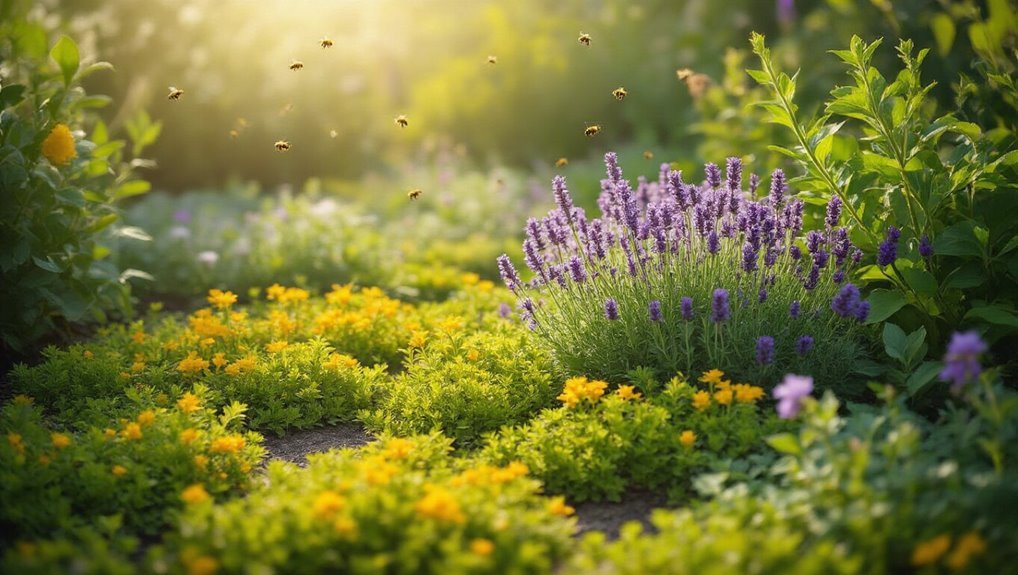
If you’re looking to cover bare patches in your garden with minimal effort, hardy groundcovers are an excellent choice.
These resilient plants spread quickly and require little maintenance once established. Consider options like creeping thyme, which not only forms a lush mat but also produces lovely flowers. To give your groundcovers the best start, using quality garden soil can greatly improve growth and resilience.
Another great choice is ajuga, known for its vibrant foliage and ability to thrive in both sun and shade.
If you prefer a more classic look, try creeping phlox; its colorful blooms create a stunning carpet effect in spring.
Lastly, sedum varieties are perfect for rock gardens, offering drought resistance and low upkeep.
If you’re interested in adding beauty and utility to your garden, you might also explore edible flower seeds that offer both ornamental value and culinary uses.
With these hardy groundcovers, you’ll enjoy a beautiful, low-maintenance garden that looks great year-round.
Drought-Tolerant Perennials for Sunny Spots
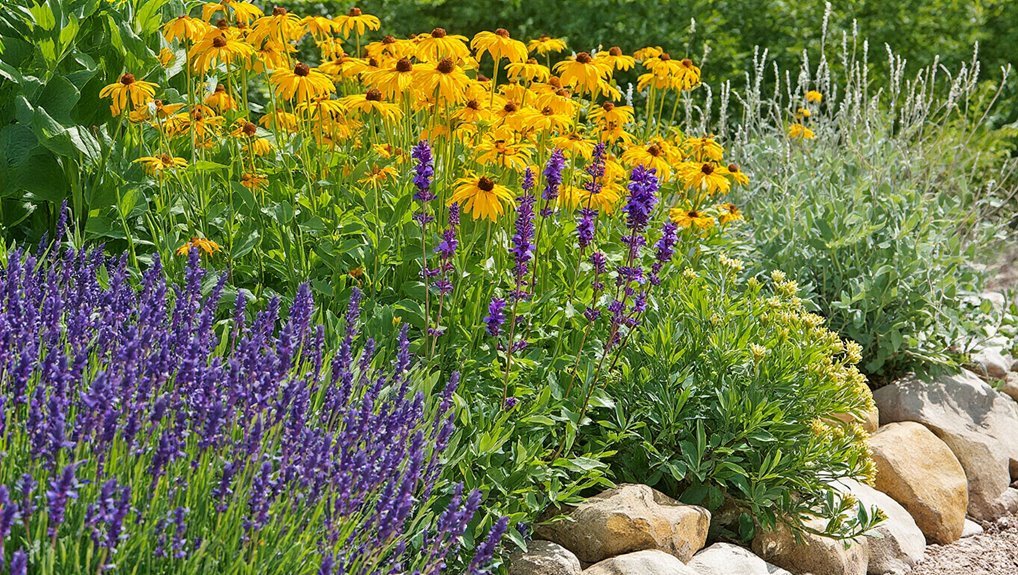
For areas in your garden that bask in the sun, drought-tolerant perennials offer a vibrant solution that thrives on minimal water. Plants like lavender, sedum, and coneflower not only withstand the heat but also add stunning colors and textures. Imagine a garden filled with these resilient beauties, effortlessly enhancing your outdoor space. To keep your garden thriving, it’s important to provide plant food that delivers essential nutrients for strong, healthy growth.
| Plant Name | Characteristics |
|---|---|
| Lavender | Fragrant, purple blooms |
| Sedum | Fleshy leaves, drought-resistant |
| Coneflower | Bright, daisy-like flowers |
| Black-eyed Susan | Cheerful yellow petals |
These low-maintenance options let you enjoy a flourishing garden without the constant worry of watering. Embrace the beauty of drought-tolerant perennials and create a sunny, vibrant oasis. For even healthier growth, consider supporting your garden with plant fertilizer tablets to provide essential nutrients with minimal effort.
Shade-Loving Perennials for Low-Light Areas
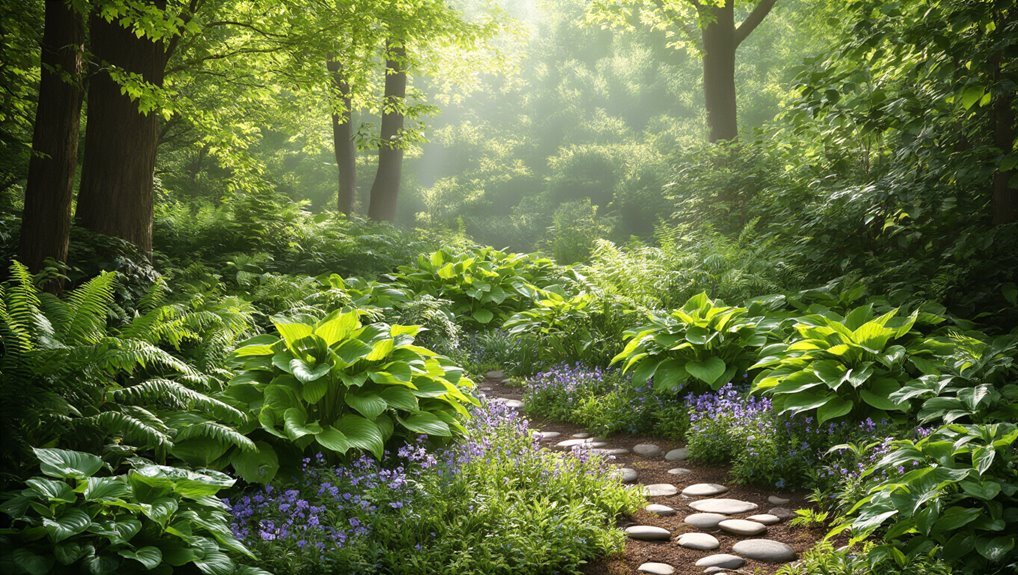
Even in the shadiest corners of your garden, you can find a variety of perennials that thrive in low-light conditions.
Consider planting hostas, which offer lush foliage and require minimal care. Their wide leaves come in various shades of green, blue, and gold, adding depth to your garden.
Another great option is the astilbe, known for its feathery plumes and ability to tolerate damp soil.
If you want something unique, try ferns; they create a beautiful, textured backdrop.
Bleeding hearts also make a stunning choice, with their heart-shaped flowers bringing a romantic touch.
These shade-loving perennials not only survive but flourish, allowing you to enjoy a vibrant garden without the hassle of constant maintenance.
Perennials That Attract Pollinators
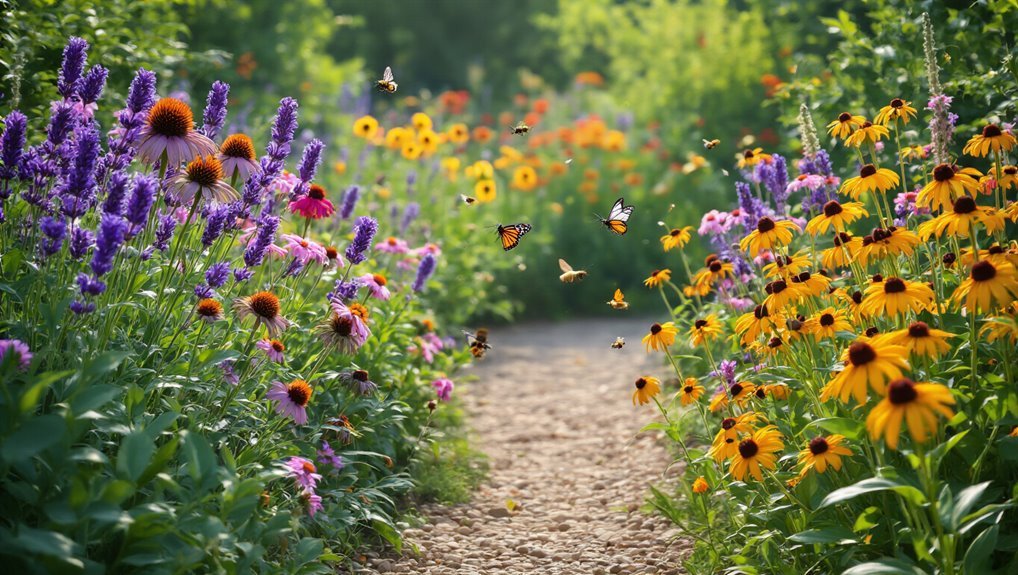
When you choose perennials that attract pollinators, you’re not just enhancing your garden’s beauty; you’re also supporting essential wildlife.
Plants like coneflowers, black-eyed Susans, and bee balm draw in bees, butterflies, and hummingbirds, creating a vibrant ecosystem. These low-maintenance options bloom year after year, providing a consistent food source for pollinators.
Consider adding lavender, which not only smells amazing but also thrives in well-drained soil.
Catmint is another excellent choice, with its long blooming period and ability to tolerate drought.
With these perennials, you’ll create a lively garden that requires minimal effort while promoting biodiversity.
Tips for Planting and Caring for Perennials
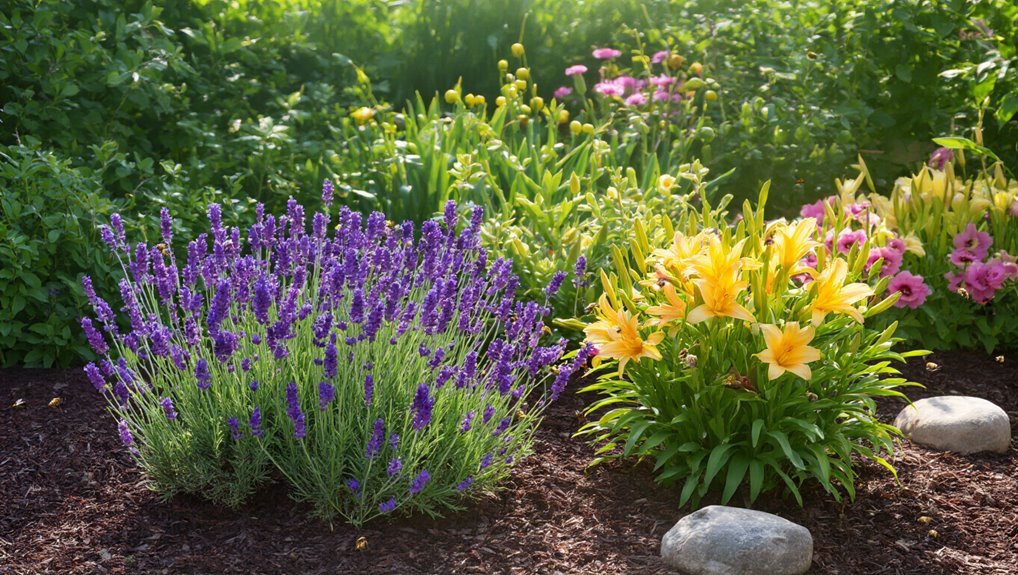
Although planting perennials can seem daunting, following a few simple tips can make the process easier and more rewarding.
First, choose the right location based on sunlight and soil type. Dig a hole twice the width of the root ball to give your plants room to grow. When planting, ensure the crown of the plant is level with the soil surface.
Water thoroughly after planting and keep the soil consistently moist until the roots establish. Mulching helps retain moisture and suppress weeds.
As your perennials grow, deadhead spent blooms to encourage more flowers. Lastly, don’t forget to check for pests and diseases regularly, as early detection can save your plants from damage.
With these tips, your garden will flourish effortlessly!
Designing a Low-Maintenance Garden Layout
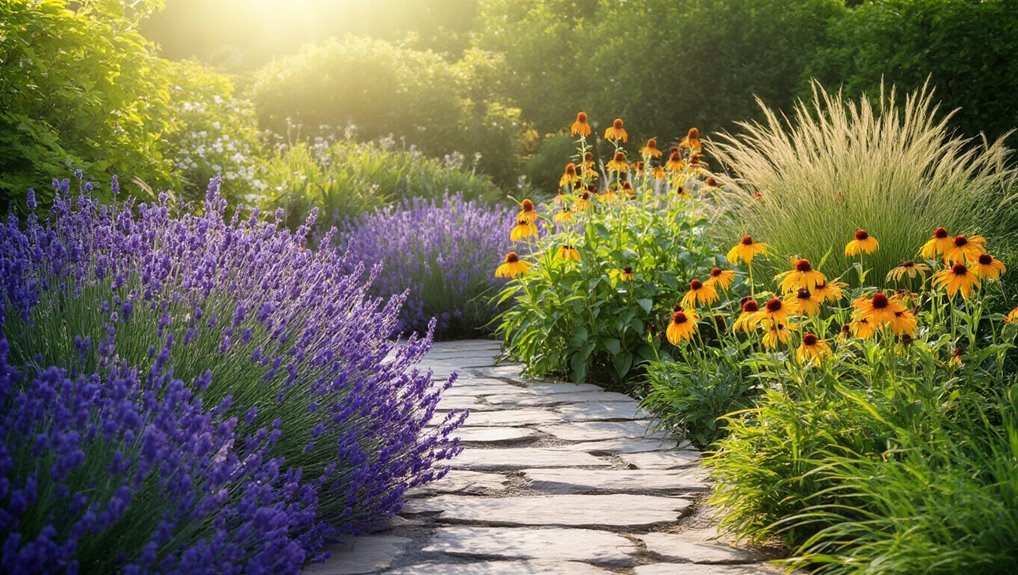
Creating a low-maintenance garden layout can significantly enhance your enjoyment of perennials while reducing the time you spend on upkeep. Start by grouping plants with similar watering and sunlight needs together. This minimizes the time you’ll need to spend on care. Consider using mulch to suppress weeds and retain moisture, and incorporate pathways for easy access.
Here’s a handy table to guide your design choices:
| Element | Description |
|---|---|
| Plant Grouping | Cluster perennials by needs |
| Pathways | Create easy access points |
| Mulch | Use for weed control and moisture |
| Seasonal Interest | Choose plants for year-round appeal |
With these strategies, you’ll enjoy a beautiful garden with minimal effort.
Frequently Asked Questions
When Is the Best Time to Plant Low-Maintenance Perennials?
The best time to plant low-maintenance perennials is in spring or early fall. You’ll give them a chance to establish roots before harsh weather hits, ensuring vibrant growth and minimal effort in your garden.
How Often Should I Water My Perennials After Planting?
After planting, you should water your perennials deeply once a week, unless it rains. During hot, dry spells, increase frequency to every three to four days. Always check soil moisture before watering again.
What Soil Type Is Best for Low-Maintenance Perennials?
For low-maintenance perennials, well-draining soil is key. You’ll want a mix of loamy and sandy textures, which helps prevent waterlogging. Test the pH, too; most perennials thrive in slightly acidic to neutral conditions.
Can I Combine Low-Maintenance Perennials With Annuals?
Yes, you can combine low-maintenance perennials with annuals for a vibrant garden. Mixing them adds seasonal interest while keeping care minimal. Just ensure the plants’ requirements align for optimal growth and health. Enjoy your colorful space!
How Do I Prevent Pests in My Perennial Garden?
Many believe pests can’t be managed naturally, but you can prevent them in your perennial garden by encouraging beneficial insects, rotating plants, using organic repellents, and maintaining healthy soil. Active care makes a big difference!
Conclusion
With low-maintenance perennials, you can enjoy a vibrant garden without the constant upkeep. Imagine lush blooms swaying gently in the breeze, while weeds and pests fade into the background. By choosing hardy groundcovers or drought-tolerant varieties, your outdoor space transforms into a serene retreat. Embrace the joy of planting and forgetting, where nature thrives effortlessly. A well-designed garden layout not only saves you time but also creates a stunning visual feast for both you and local pollinators.

